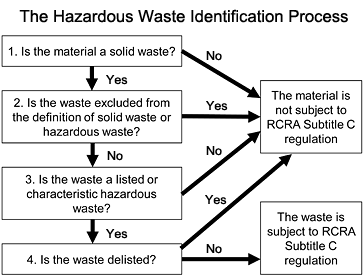These lists include specific commercial chemical products in an unused form. Toxic Waste T Acute Hazardous Waste H Ignitable Waste I Corrosive Waste C Reactive Waste R Toxicity Characteristic Waste E F-Listed Wastes.

Examples Of Hazardous And Non Hazardous Waste Produced In The Nhs In Download Table
The following violations are alleged in.

. Ergon is stated to be a generator of hazardous waste as those terms are defined in the hazardous waste regulations. Ignitability Reactivity Corrosivity Toxicity Listed hazardous wastes are materials specifically listed by regulatory authorities as hazardous. Solids liquids and gases.
Wastes included on the K-list can be found in the regulations at 40 CFR 26132. The forth category of hazardous waste contains both radioactive and toxic components. Some pesticides and some pharmaceutical products become hazardous waste when discarded.
Hazardous waste is waste that has substantial or potential threats to public health or the environment. EPAs regulations in the Code of Federal Regulations 40 CFR define four hazardous waste characteristic properties. When these materials find their way into the oceans it will directly affect marine wildlife that could die or suffer harmful consequences.
Hazardous waste is any solid waste that either exhibits any of the characteristics of hazardous waste or is a listed EPA waste. Wastes that come from the F-list are non-specific source wastes. Definition of Hazardous Wastes.
Much of this hazardous material is stored in landfills or other containment areas. Substance Hazardous Waste No. MDEs F-list of hazardous waste waste codes F001 thru F005 contains numerous spent solvents including but not limited to methylene chloride xylene 111-tricholorethane and ethyl acetate.
Ignitability corrosivity reactivity or toxicity see 40 CFR 26121-26124. Characteristic hazardous wastes are materials that are known or tested to exhibit one or more of the following hazardous traits. 153 rows Empty P-waste chemical containers.
For both F and K-listed wastes the EPA uses the following traits to indicate what makes them hazardous to human and environmental health. Unusedoff-specification solvents are typically found on the MDEs U-list of hazardous waste. Most commercially generated waste is low-level mixed waste since it also contains low-level radioactive waste.
Many industries generate it including the pharmaceutical medical nuclear and other energy industries. P-listed codes and certain dioxin codes F020-F023 and F026-F028 are considered to be acute whereas the remaining codes are non-acute. Hazardous wastes are those wastes that are potentially hazardous to human health andor the environment due to their nature.
Consolidate storage of hazardous material The specific gravity of a product can be found on the Material Safety Data Sheet. Around 10 percent of all dredged materials are polluted with heavy and toxic metals like cadmium and mercury. See 40 CFR 26010.
Toxic waste in the oceans includes industrial waste sludge and radioactive waste. In addition EPA Hazardous Waste Codes are also classified as acute and non-acute. These wastes are of the more commonly produced and identified oftentimes as dangerous goods.
Discarded computer printer paper. Hazardous wastes can be in the form of liquids solids contained gases or sludges. 51 Listed Hazardous Wastes F K U and P lists The EPA has 4 lists of hazardous wastes.
The P-list and the U-list discarded commercial chemical products. Any waste with a contaminant meeting the definition of any of these lists is considered hazardous waste regardless of the hazardous characteristics. Which of the following is a method for the safe handling of hazardous waste and hazardous material.
Cooperative efforts by federal and provincial environment departments and members of industry have led to the development of the following working definition of hazardous wastes. A waste must be in one of the following 13 categories to qualify as a K-listed hazardous wasteWood preservationOrganic chemicals manufacturingPesticides manufacturingPetroleum refining. These types of wastes typically include bulbs mercury-containing equipment pesticides and batteries.
Hazardous waste is defined as any waste with properties that can cause harm or danger to humans or the environment if contact is made. Waste that includes paper food wastes cans bottles yard waste glass wood and similar items is called. If these hazardous waste sites are not properly designed or managed their contents can be released into the surrounding environment posing a threat to public health.
Determining the identification of hazardous waste can be complicated so there are several regulatory steps that need to be taken for proper disposal including an understanding of the four primary characteristics of. DEC has the same listing as the EPA with one additional list for Polychlorinated Biphenyl PCB wastes. According to the EPA Simply defined a hazardous waste is a waste with properties that make it dangerous or capable of having a harmful effect on human health or the environment Hazardous waste also includes different physical forms including.
Substance Hazardous Waste No. There are 9 classific. Also known as commonly-generated universal wastes are another classification for hazardous wastes.
Hazardous listing a waste as hazardous because we found them to pose substantial present or potential hazards to human health or the environment. Dangerous wastes can also be produced through different means. List of Acutely Hazardous Wastes.

The Simple Way To Assess Your Hazardous Waste Report Obligations

Hazardous Waste An Overview Sciencedirect Topics

Disposal Of Controlled Substances Met Bio Medical Waste Management Drugs Abuse Medical
0 Comments